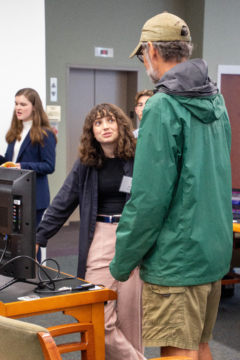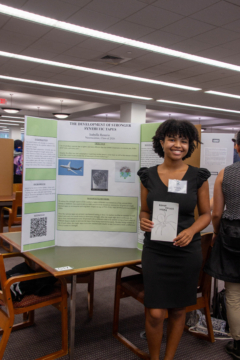Undergraduate researchers representing 45 different majors in the arts & humanities, social sciences and STEM-related disciplines presented their findings at William & Mary’s 2023 Fall Undergraduate Research Symposium in Swem Library’s Read and Relax room on Sept. 22.
In total, over 200 students who received Charles Center summer research grants and alternatively funded research projects occurring on campus showcased their work.
According to Charles Center Director Elizabeth Harbron, the symposium strives to celebrate the diverse work of undergraduate students and the transformative nature of faculty-mentored research.
“Undergraduate research comes in so many forms and looks so different, depending on the topic and field, that it’s hard to appreciate how much is happening at William & Mary,” Harbron said. “The symposium is meant to appreciate the range and depth of amazing work our students are doing alongside faculty mentors—in the summertime and throughout the academic year.”

Over the course of the day, a steady stream totaling nearly 700 symposium-goers dropped by to check out various projects and to hear from student researchers themselves.
A number of projects highlighted William & Mary’s embrace of collaborative interdisciplinary approaches, with many humanities students focusing on STEM-related projects, and vice versa.
Seneca RiceWoolf ’25 shared findings from her project, “Matoaka Microplastics: Quantity, Characteristics, and Significance.” RiceWoolf is an environmental policy and sociology double major. Her research focuses on the presence of microplastics in nearby Lake Matoaka and potential mitigation strategies to prevent their accumulation.
“During this project, I enjoyed connecting with VIMS/William & Mary staff, learning new lab techniques and spending my summer paddling through Lake Matoaka,” RiceWoolf wrote in an email. “It helped me realize that I am passionate about science that prompts action: informing understandings about local development, species behavior and fundamental ecosystem characteristics.”
The presenters on Friday also included Rachel Nguyen ’24, Karino Gibson ’24 and Darrison Haftarczyk ’26, who participated together in the Vanderbilt Institute for Infection, Immunology and Inflammation’s Artist in Residence program this past summer and worked with Dr. Timothy Hand’s lab at the University of Pittsburgh. Haftarczyk was tasked to create a visual abstract of Hand’s latest academic paper, combining art and science in an interdisciplinary approach.
“Working beside the lab was an incredible experience for me as it helped me to see the way that scientific research is communicated in a whole new light,” Haftarczyk wrote in an email. “In a time with so much misinformation, clear communication is more important than ever, and we believe that art can help lead to this.”

Isabella Rosario ’26, a neuroscience major in the pre-med program, displayed her groundbreaking work with brown recluse spiders, inspired by their tough and complex webbing and the potential to construct a synthetic tape that could be stronger than carbon fiber-based composites. Though Rosario had never been comfortable with spiders in the past, she was interested in discovering if a synthetic tape made from webbing could be used in the medical field.
“Imagine having gauze that’s made out of silk,” Rosario said. “Then you don’t have to take off anything because it would evaporate, and maybe that could even help the healing properties.”
Since carbon fiber is found in products such as jets, cars and bullet-proof vests, Rosario believes that creating an alternative product could have positive environmental impacts as well.
“By creating a material that is lighter and stronger than carbon fiber, that means, in the grand scheme, we could produce this material that would lead to less fuel consumption – having a lighter jet, or maybe even a faster jet,” Rosario said. “If we could produce a better material than carbon fiber, that could do a lot of good for the environment.”
The complete list of student projects from this year’s symposium can be found on the Charles Center’s online program.
The application for Charles Center semester research funding is open now, with deadlines in October (priority) and December (if funds remain). Applications for 2024 summer research grants are due Feb. 19, 2024.

